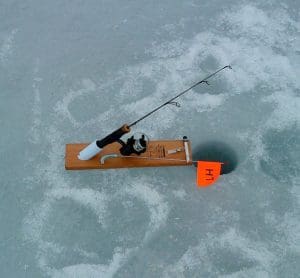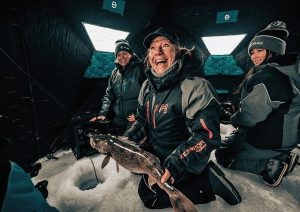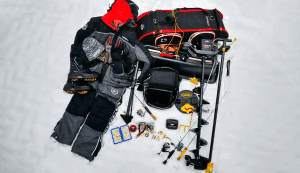
Welcome to the chilly world of ice fishing! In the realm of winter angling, where frozen lakes and rivers become our playgrounds, mastering the art of ice fishing techniques is key to reeling in those prized catches. Whether you’re a seasoned ice angler or a newbie braving the frozen waters for the first time, understanding the ins and outs of effective ice fishing techniques can make all the difference between a successful outing and a cold, quiet day on the ice.
In this comprehensive guide, we’ll dive into the essentials of ice fishing techniques, covering everything from basic setups to advanced strategies. Whether you’re aiming to hook a trophy walleye, perch, or northern pike, we’ve got you covered with practical tips and easy-to-follow advice. So grab your gear, bundle up, and let’s embark on a journey to become masters of winter angling!
Contents
Essential Gear for Ice Fishing.🐟
When it comes to venturing onto the icy waters for fishing, having the right gear is crucial. Whether you’re an enthusiastic novice or an experienced ice angler, having the essentials can make the difference between a successful outing and a disappointing one. Here’s a list of the basic items you’ll need for your next ice fishing adventure:
Rods:
Ice fishing rods are shorter than traditional fishing rods, typically ranging from around 24 to 36 inches in length. This facilitates maneuverability in tight spaces and allows for greater sensitivity to detect fish bites under the ice.
Lures:
Lures for ice fishing come in a variety of shapes and sizes, but the most common ones include jigs, vertical jigs, and spoons. Opt for bright and flashy colors that can catch the attention of fish in the cold, dark waters.
Hooks:
Hooks for ice fishing are smaller and lighter than those used in traditional fishing. Look for hooks of appropriate size for the species you expect to catch and make sure to have enough spares in case you need to change them during your fishing trip.
Safety Equipment:
Safety is paramount when ice fishing. Make sure to carry items such as ice picks, rescue ropes, and a life jacket specifically designed for ice conditions. Additionally, always check the safety of the ice before venturing out, as ice thickness can vary depending on weather conditions and location.
5 Recipes with Angler Fish: Exploring Culinary Delights from the Depths
Dive into the world of culinary creativity with our curated collection of five tantalizing recipes featuring the Angler fish. From savory stews to crispy fillets, discover delicious ways to elevate this unique deep-sea delicacy to new heights on your dinner table. Explore the depths of flavor and embark on a culinary adventure that will leave your taste buds craving for more.
Basic Ice Fishing Techniques.🐟
When it comes to ice fishing, mastering the basic techniques is essential for success in this thrilling winter adventure. Here are some of the fundamental techniques that every ice angler should know to make the most of their time on the ice:
Jigging: Lure Fish with Irresistible Movements.
Jigging is a classic and effective technique that involves moving the lure up and down to simulate the movement of potential prey. This technique is especially effective for attracting predator fish such as pike and trout, which are drawn to the vibrant and erratic movements of the lure.
Tip-Ups: Keep Bait in Fish’s Line of Sight.
Tip-ups are mechanical devices that keep the bait suspended vertically under the ice, allowing anglers to monitor fish bites. This technique is ideal for fishing species that prefer moving bait, such as pike and catfish. By placing the tip-up in shallow waters near aquatic vegetation, you can increase your chances of success.
Deadstick: A Classic Technique for Patient Anglers.
Deadstick, also known as “line fika,” is a simple yet effective technique that involves dropping a hook or bait into the water and waiting for fish to approach. This technique is ideal for anglers who prefer a more relaxed and patient approach to ice fishing. By keeping the line still, you can take advantage of the curiosity of fish and tempt them with natural or artificial bait.
Advanced Ice Fishing Techniques.🐟
In the frosty world of ice fishing, mastering advanced techniques can take your angling game to a whole new level. These advanced methods go beyond the basics and require a deeper understanding of the underwater world. Let’s dive into some advanced ice fishing techniques that will help you reel in those elusive catches:
Locating Fish: Unveiling the Underwater World.
Finding fish beneath the ice can be like searching for hidden treasure. One advanced technique for locating fish is to use a fish finder or sonar device. These handy gadgets emit sound waves that bounce off objects underwater, allowing you to pinpoint the location of fish and structure beneath the ice. By interpreting the sonar readings, you can identify promising fishing spots and increase your chances of success.
Interpreting Sonar: Decoding the Signals.
Interpreting sonar readings is a skill that can greatly enhance your ice fishing experience. Pay attention to the size, shape, and movement patterns of the marks on the sonar screen. Large, arch-shaped marks typically indicate larger fish, while smaller marks may represent baitfish or smaller predators. By analyzing the sonar data and understanding fish behavior, you can make informed decisions about where to drill your holes and how to present your bait effectively.
Utilizing Shelters: Beating the Chill.
Ice fishing shelters provide much-needed protection from the elements and can significantly enhance your comfort and safety on the ice. These portable shelters come in a variety of styles, from simple flip-over models to fully insulated pop-up tents. Not only do shelters keep you warm and dry, but they also allow you to stay on the ice for longer periods, increasing your chances of catching fish. Set up your shelter near your fishing hole, kick back, and enjoy the cozy ambiance while you wait for the fish to bite.
The Gastronomy of the Mediterranean Coast.
Embark on a culinary journey along the sun-kissed shores of the Mediterranean coast. From fresh seafood dishes bursting with flavor to fragrant olive oils and vibrant herbs, immerse yourself in the rich and diverse gastronomic traditions of this enchanting region. Discover the secrets behind beloved Mediterranean recipes and savor the taste of coastal cuisine at its finest.
Tips and Tricks for a Better Ice Fishing Experience.🐟
When it comes to ice fishing, some simple tips can make the difference between a successful outing and a disappointing one on the ice. Here are some practical tricks to enhance your fishing experience and increase your chances of success:
Patience Pays Off: Be Patient and Persistent.
Ice fishing requires patience, as fish may not always bite immediately. Settle in, relax, and give yourself plenty of time to wait for the fish to come to you. Remember, good things come to those who wait!
Safety First: Stay Safe on the Ice
Safety should always be your top priority when ice fishing. Make sure to check the thickness of the ice before venturing out, and avoid areas with cracks or thin ice. Wear appropriate clothing and equipment, including ice picks and a life jacket, to ensure you stay safe on the ice at all times.
Adapt to the Elements.
Weather conditions can change rapidly on the ice, so it’s important to be prepared for anything. Dress in layers to stay warm and dry, and bring along extra clothing in case the weather takes a turn for the worse. Keep an eye on the forecast and be ready to adapt your fishing strategy accordingly.
Stay Mobile: Explore Different Fishing Spots.
Don’t be afraid to move around and explore different fishing spots until you find the perfect location. Fish can be unpredictable, so it’s important to be flexible and willing to try new spots if you’re not having luck in one area. By staying mobile, you can increase your chances of finding active fish and having a successful day on the ice.
Learn from Experience: Keep Learning and Improving.
The best way to improve your ice fishing skills is to learn from experience. Pay attention to what works and what doesn’t, and don’t be afraid to experiment with different techniques and strategies. Take note of successful outings and apply what you’ve learned to future fishing trips. With time and practice, you’ll become a skilled ice angler capable of reeling in trophy-worthy catches.
Expert Answers to Common Ice Fishing Questions.🐟
What are the best techniques for ice fishing?
The best techniques for ice fishing vary depending on environmental conditions and target species, but some fundamental techniques include jigging, using tip-ups, and deadsticking. Jigging involves moving the bait up and down to attract fish, while tip-ups are mechanical devices that keep the bait suspended vertically under the ice, allowing anglers to monitor bites. Deadsticking, on the other hand, involves dropping a hook or bait into the water and waiting for fish to approach. Mastering these basic techniques will help you succeed in ice fishing.
What equipment do I need to start ice fishing?
To start ice fishing, you’ll need a basic set of equipment including an ice-specific fishing rod, lures such as jigs and spoons, appropriately sized hooks, a portable shelter to protect you from wind and cold, and safety equipment such as ice picks and a life jacket designed for ice conditions. Additionally, it’s important to dress appropriately with layers of warm, waterproof clothing to keep you comfortable during your fishing outing.
How can I ensure I stay safe while ice fishing?
Safety is paramount when ice fishing. Before venturing onto the ice, always be sure to check the thickness and quality of the ice, avoiding areas with cracks, currents, or moving water. Carry safety equipment such as ice picks, a life jacket, and a rescue rope, and always keep your cell phone or an emergency communication device handy. Additionally, fish with a buddy whenever possible and communicate your fishing plan and location to a trusted individual before heading out.


